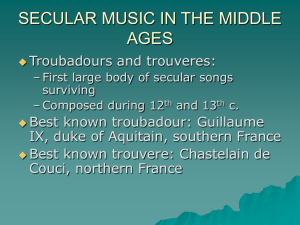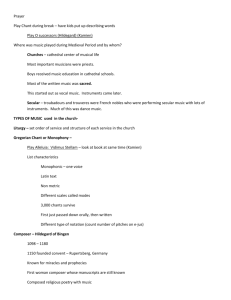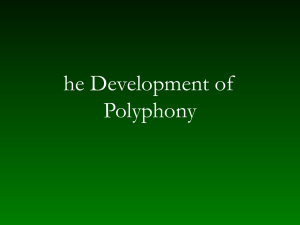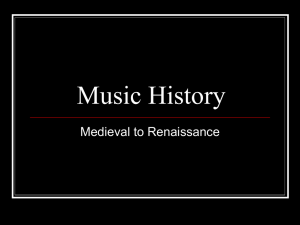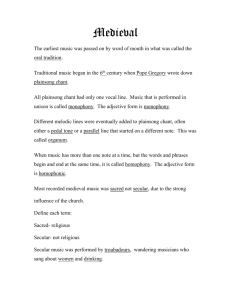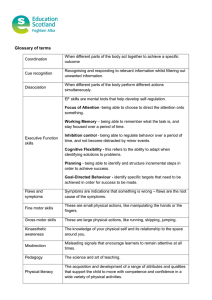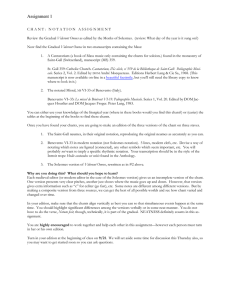21M.220 Fall 2010 Class #7 1
advertisement
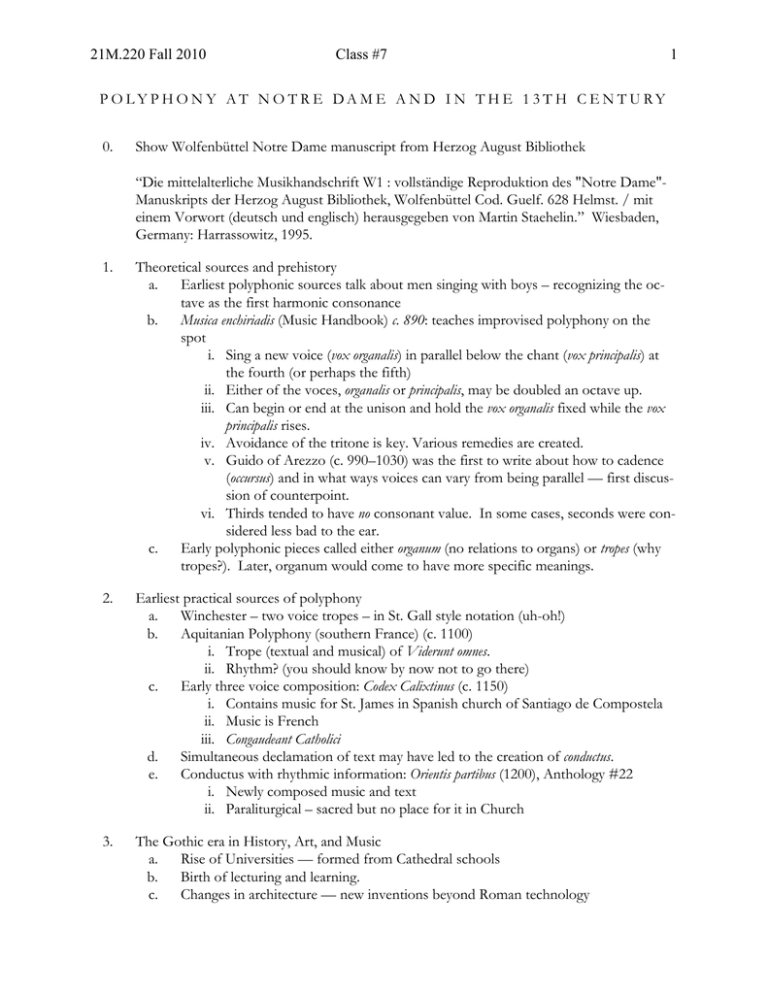
21M.220 Fall 2010 Class #7 1 P OLYP HO N Y AT N O T R E DA M E A N D I N T H E 1 3 T H C ENT U RY 0. Show Wolfenbüttel Notre Dame manuscript from Herzog August Bibliothek “Die mittelalterliche Musikhandschrift W1 : vollständige Reproduktion des "Notre Dame"Manuskripts der Herzog August Bibliothek, Wolfenbüttel Cod. Guelf. 628 Helmst. / mit einem Vorwort (deutsch und englisch) herausgegeben von Martin Staehelin.” Wiesbaden, Germany: Harrassowitz, 1995. 1. Theoretical sources and prehistory a. Earliest polyphonic sources talk about men singing with boys – recognizing the octave as the first harmonic consonance b. Musica enchiriadis (Music Handbook) c. 890: teaches improvised polyphony on the spot i. Sing a new voice (vox organalis) in parallel below the chant (vox principalis) at the fourth (or perhaps the fifth) ii. Either of the voces, organalis or principalis, may be doubled an octave up. iii. Can begin or end at the unison and hold the vox organalis fixed while the vox principalis rises. iv. Avoidance of the tritone is key. Various remedies are created. v. Guido of Arezzo (c. 990–1030) was the first to write about how to cadence (occursus) and in what ways voices can vary from being parallel — first discussion of counterpoint. vi. Thirds tended to have no consonant value. In some cases, seconds were considered less bad to the ear. c. Early polyphonic pieces called either organum (no relations to organs) or tropes (why tropes?). Later, organum would come to have more specific meanings. 2. Earliest practical sources of polyphony a. Winchester – two voice tropes – in St. Gall style notation (uh-oh!) b. Aquitanian Polyphony (southern France) (c. 1100) i. Trope (textual and musical) of Viderunt omnes. ii. Rhythm? (you should know by now not to go there) c. Early three voice composition: Codex Calixtinus (c. 1150) i. Contains music for St. James in Spanish church of Santiago de Compostela ii. Music is French iii. Congaudeant Catholici d. Simultaneous declamation of text may have led to the creation of conductus. e. Conductus with rhythmic information: Orientis partibus (1200), Anthology #22 i. Newly composed music and text ii. Paraliturgical – sacred but no place for it in Church 3. The Gothic era in History, Art, and Music a. Rise of Universities — formed from Cathedral schools b. Birth of lecturing and learning. c. Changes in architecture — new inventions beyond Roman technology 2 4. The Music Treatise of “Anonymous IV” a. How good are your lecture notes? (one theory…) b. Englishman, from 1270 or 1280: one hundred years after this all begins! 5. Leonin (=Leoninus magister) a. Organum purum duplum — long melismas over a fixed chant note b. tenor c. Discant / Discant clausula(e) d. Organum in unknown rhythm, discant in fixed rhythm. e. Made the Magnus Liber Organum from the Gradual and the Antiphoner— remains: W1 = Wolfenbüttel, W2, F, Madrid. f. optimus organista g. Viderunt omnes – who sang this music? 6. Perotin (=Perotinus magnus) a. Organum purum quadruplum and Organum purum triplum b. All in fixed, modal rhythm c. “abbreviated” (=edited?) the Magnus Liber d. optimus discantor “better than Leoninus” e. made great organum quadruplum including “Viderunt” and “Sederunt” 1 f. Viderunt omnes for Christmas 1198 g. antecedent-consequent building material. 7. Modal Rhythm a. Timeline: Léonin 1150 b. Pérotin 1200 Montpellier codex. Anon. IV Vitry/Ars Nova 1250 1300 1330 Perotinian or Modal Rhythm: Shape of individual notes not indicative of duration. Sequence of ligatures indicates the modal quality of the passage. 1 The performance of Perotin’s Sederunt principes is beautifully described near the end of Umberto Eco’s The Name of the Rose, a must read for any medieval aficionado. 21M.220 Fall 2010 Class #7 3 optional: Mode 4 exists only in theoretical sources; it is not found in practical music and thus is unlikely to be confused with mode 5. After each ordo, a tick indicating a rest is normally found. In some sources (Bam.) the duration of the rest is indicated by its length. In others (Mo.) duration is determined by context. The difficulty in interpreting rhythm comes from (1) repeated notes (which cannot be ligated) (2) extensio modi (omission of notes by extending others) and (3) fractio modi (breaking up of a L of a mode into smaller parts). The plica is a symbol derived from chant liquescence to indicate motion to another pitch at the end of a note or ligature. The plica can be written separately like ( ) but is most often discussed in the theoretical sources when it forms part of a ligature and is indicated by a tail on the right side of the ligature ( ). The tail can point upwards or downwards indicating either an ascending or descending plica. The pitch of the plica note is determined by context (see Discantus positio vulgaris). Mode 6, both in practical sources and in theory, is often described as being a modification of either mode 1 or mode 2 through fractio modi and plicas. Thus in common practical use, there are 2 measurable modes (1 & 2) and 2 ultra mensurabilis (3 & 5). In theoretical literature of the early 13th century, the “proper” long has the duration of 2 tempora. A “long before long” contains three tempora (as for example, in mode 5). 8. Thirteenth-century motet (ars antiqua as called by the fourteenth century) a. Discant Sections become Free Clausulae b. Clausula to Motet c. Performance: Essential Cookiness Assignment for next THURSDAY: Do (1) of the following: a) Analyze the section “VIDERUNT OMNES” from Perotin’s piece of the same name (i.e., stop at “fines terrae”). How does it work? What motives recur? What are the intervals used? How does the piece show “antecedent-consequent” structure? b) Compose a three voice bitextual-motet in the style of the Montepellier codex pieces. You may use texts of your choice and a tenor of your choice drawn from Gregorian chant (use only a few notes, then repeat your tenor). Your texts may be in any language or (better) languages. MIT OpenCourseWare http://ocw.mit.edu 21M.220 Early Music Fall 2010 For information about citing these materials or our Terms of Use, visit: http://ocw.mit.edu/terms.
